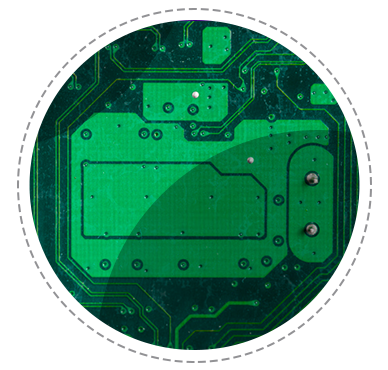
PCB Fabrication Capabilities California
When developing a reliable electronic product, selecting the right PCB assembly fabrication solution is paramount. Neglecting the quality of your boards can lead to costly errors, product malfunctions, and damage to your company's reputation.
Understanding Printed Circuit Board (PCB) fabrication is crucial to appreciate its role in PCB development. PCB fabrication involves the manufacturing process where copper layers are laminated onto a substrate to create a functional circuit board. This process includes intricate steps such as designing the circuit layout, etching copper traces, drilling holes for component placement, and applying solder mask and silkscreen layers. The quality and precision of circuit board fabrication directly impact the overall performance, reliability, and longevity of electronic devices.
At Technotronix, we excel in PCB fabrication services with advanced capabilities in custom circuit board fabrication. Our PCB manufacturing facilities in the USA ensure high-quality production, from prototyping to assembly and testing. Trust our expertise in printed circuit board fabrication to deliver superior quality boards that meet your specific requirements and exceed industry standards. Contact us to explore our comprehensive PCB fabrication services tailored to your project needs.
What does PCB Fabrication Process mean?
Even before defining circuit board fabrication, let us look at some of the other terms that are commonly associated with the PCB development process and understand the interrelationships between them.
PCB Development
PCB development refers to the comprehensive process of evolving a PCB design into a fully realized product, spanning from initial design through to final production. This encompasses crucial stages such as design refinement, prototype fabrication, and rigorous testing to ensure functionality and reliability in electronic applications.
PCB Manufacturing
The other term commonly used is PCB manufacturing. This really is a two-step process comprising of:
- Fabrication: Creating the bare PCB by laminating copper layers onto a substrate and etching circuit patterns.
- PCB Assembly: Mounting electronic components onto the fabricated PCB to create a functional electronic device.
PCB Testing
PCB Testing is a critical step following PCB manufacturing, essential for identifying errors and implementing necessary changes to prevent issues in subsequent stages or during operation.
PCB Assembly
PCB assembly involves the process of mounting components onto the bare board, utilizing techniques such as through-hole technology, surface mount technology (SMT), or a combination of both.
The PCB Fabrication Process
With these terms clarified, let us move to the printed circuit board fabrication process. This is the process where the PCB design is converted into the physical structure. PCB Fabrication involves the following:
- Imaging the layout on the copper clad laminates
- The next step is to etch the excess copper
- Laminating board materials and creating PCB layer stackup
- Drilling holes
- Etching of copper, this time from the surface layers
- Plating pin holes and via holes
- Solder masking
- Silkscreen printing reference
- Adding the requisite finish
There are also a number of printed circuit board fabrication methods, primary among them being:
- Etching- Etching is a cost-effective process that utilizes chemical solutions to selectively remove unwanted areas from the PCB board, ensuring precise circuit patterns are left behind.
- Manual- In this method a manual design is drawn onto the board.
- Photographic- In this method, a drawing made of photoresist material is projected onto the board.
- Direct etch- Here a design is printed on a laser printer. This is in turn ironed on to the circuit board.
- Silkscreen- This involves the use of photosensitive material.

It is extremely important to understand the printed circuit board fabrication process as it is an outsourced activity that a Contract Manufacturer performs for you as per the specifications provided by you. In many cases the contract manufacturer does not have access to the intent behind your design as well as the choice of material, layout etc. that is made by you. All of this, in turn, impacts the following:
- Manufacturability - Simply put this follows from your design choices. For example, at the design stage you need to ensure that there are enough clearances between surface elements, the material selected has high Coefficient of thermal expansion, and more.
- Yield Rate - If you specify parameters that stretch the tolerance of the equipment, you could land up in a situation where a large number of boards are not usable.
- Reliability - It is important that your board’s construction meets the specified levels of reliability. For rigid boards, for example, there are 3 classification levels set. If the board does not meet the level of reliability desired, it could lead to inconsistencies in operation and even failure.
We endeavor to deliver following PCB Fabrication capabilities & core competences:
With detailed knowledge about the PCB Fabrication process and PCB fab capabilities of the manufacturer, you will be able to make your design choices with caution as these choices will have far-reaching consequences in PCB development and production. It is imperative that the Design for Manufacturing guidelines be followed so as to ensure that you do not run into any problems at a later stage. This will also ensure that any delays as well as any unforeseen costs are avoided.
Do you have any PCB Fabrication Capabilities requirements? Request a free quote. Alternatively, email BoM, Gerber files, and other required details at [email protected] or call us 714/630-9200.

PCB Assembled in 24 hours
Kitted and Turn-Key option as per customers requirement.

REQUEST OUR BROCHURE
 Request Brochure
Request Brochure Please provide your email address. We’ll send you copy of our brochure in a PDF format.